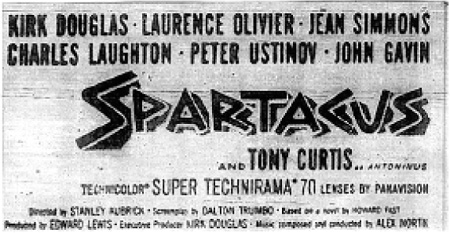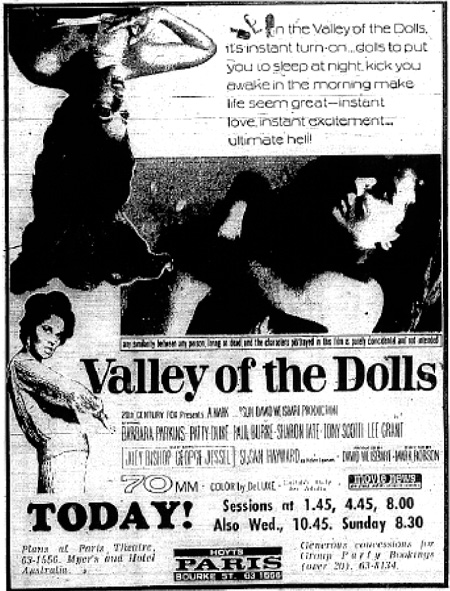The
history of some cost- saving approaches to the 70mm experience |
Read more at in70mm.com The 70mm Newsletter |
| Written by: Eric White, Melbourne, Australia | Date: 22.05.2010 |
 Spartacus, in the same process, began a
long season in Melbourne on
8 December. 1960. Spartacus, in the same process, began a
long season in Melbourne on
8 December. 1960.‘Blow-ups’ became popular as a sort of Claytons 70mm: the 70mm you have when you are not having 70mm. Super Technirama 70 was a 70mm process shot on 35mm film. The 35mm film was run through the camera sideways, as with VistaVision, but photographed through an anamorphic lens with a 1.5:1 squeeze. (CinemaScope had a 2:1 squeeze). The frame was eight perforations wide, but the height was exactly the same as that of the 70mm frame. This enabled production of a 70mm size image just by removing the squeeze and printing on to 70mm stock. Hey presto! A print that was every bit as sharp as if it had been filmed on 70mm, but much cheaper to shoot and much, much easier to handle at the shooting level. A director could get his “dailies” daily, instead of having to send the film to Hollywood, Rome or Britain for processing. This was a boon if filming in Spain, where many of the big spectacles were produced. Super Technirama 70 was developed by Technicolor and it was a logical extension of their Technirama process, whereby conventional CinemaScopestyle prints were derived from the 35mm-sideways negative. Super Technirama 70 was first used for Disney’s "Sleeping Beauty" (1959), "Spartacus" (1960) and "King of Kings" (1961), and overall was used for about thirty productions. Remember however, when you see in the credits that a movie was filmed in Super Technirama 70, it wasn’t really. It was filmed on 35mm. The other quasi-70mm films were the ‘blow-ups’ from a conventional 35mm negative. For the most part they were filmed in Panavision, though a few were blown up from ‘spherical’ or non-anamorphic negatives. Since the ‘blowing-up’ was done from a master derived from the negative, the definition and colour saturation of these prints was excellent. One could not tell them from Todd-AO. |
More in 70mm reading: in70mm.com's page about films blown up to 70mm The lost world of 70mm Theatres By Ian Hanson A comment to "The lost world of 70mm Theatres" Cinerama At the Plaza Camera 65 and the Metro Bourke Street Bigger than… |
 The poster says 70mm and the print was,
but Valley of the Dolls was a simple ‘blow-up’ from 35mm. Image: The
Herald 13 June 1968. State Library of Victoria. The poster says 70mm and the print was,
but Valley of the Dolls was a simple ‘blow-up’ from 35mm. Image: The
Herald 13 June 1968. State Library of Victoria.Why were these films ‘blown-up’? Sometimes the decision was made during production to promote a fairly modest property into block-buster. Such a film was "The Cardinal" (1963), the first to get the treatment. The first 70mm ‘blow-up’ to be screened in Melbourne was "Valley of the Dolls" (1967) which had a good run at the Paris. Sometimes a major production was filmed in 35mm and then ‘blownup’ simply for reasons of economy. "Doctor Zhivago" (1965) was in this category. Sometimes the demands of location shooting made it necessary to shoot on 35mm and sometimes there was just not enough 70mm equipment available. Furthermore, when it was seen just how good the 70mm ‘blowups’ could look, producers saw no reason to film in the big format. By 1970 'blowing-up’ had become commonplace. There were more 70mm prints around that ever before, but the amount of filming in 70mm was decreasing rapidly. By 1972 it was almost extinct. The last movies to be filmed in 70mm for many years were "Ryan’s Daughter" (1970) and "The Last Valley" (1971). 70mm ‘blow-ups’ continued through the 1980s, but by the 1990s interest in them had all but disappeared. The Panavision anamorphic format was also in decline, though in the early 1990s Panavision began a comeback. Australia’s one and only 70mm movie was "Mad Max III - Beyond Thunderdome" (1984). It was a ‘blowup’ and ran at the Capitol, Melbourne. Two prestigious directors attempted to revive 70mm photography in the mid 1990s. Ron Howard’s "Far And Away" (1992) and Kenneth Branagh’s "Hamlet" (1996) used the medium, but at the box-office it did nothing for either. A recent revival of 70mm was sparked through restoration of bigscreen productions such as "Lawrence Of Arabia" and "Spartacus". When talk turns to ‘lost’ movies those in most danger are the big-format musicals and dye-transfer printing process for 70mm - Technicolor never developed the technology. All 70mm prints and negatives were Eastman colour or the equivalent, and therefore all are prone to fading to pink. Add to this the problems of acetate film stock going ‘vinegary’ and you have real trouble. Not only is the film washed out, it is shrunken, buckled and brittle to the point of being unrunnable. It can be restored digitally, but the process is extremely expensive. The results can be stunning however. A handful of 70mm block-busters have been restored and new 70mm prints struck. Occasionally lost sequences have been put back. Examples of these restorations are "It’s A Mad, Mad, Mad, Mad World"; "2001, A Space Odyssey", "Lord Jim" and "Patton". Currently someone is said to be working on "The Big Fisherman". Ironically, it is the popularity of DVD that is helping the preservation of these films, as a good copy has to be produced for the DVD market. The recent DVD release of "Around The World In 80 Days" is an example of this. It is an excellent transfer. A problem with issuing new 70mm prints is the soundtrack. All 70mm prints used to have their soundtracks on magnetic stripes. It seems that these days there are problems with the solvents used in applying these tracks to the film. By modern standards they are considered to be toxic. At the same time, it is now possible to use the DTS digital soundtrack system for 70mm films, so this would seem to solve the problem. The trouble is that while there are still plenty of cinemas with functional 70mm projectors, very few of them have the 70mm DTS equipment. So if you want to issue a 70mm print, what do you do? Use fiendishly expensive magnetic sound tracks so more people can run the print, or produce a cheaper print that not many exhibitors can use? Just how many movies were filmed in 70mm? The numbers might surprise you. According to Carr and Hayes in their Wide Screen Movies, in the US. Britain and Western Europe, there were only about 50! There were about 450 ‘blow-ups’. It was the Soviets who went for 70mm filming in a big way. There were about 300 productions filmed in this medium in the Soviet Union. |
|
| Go: back - top - back issues - news index Updated 21-01-24 |
